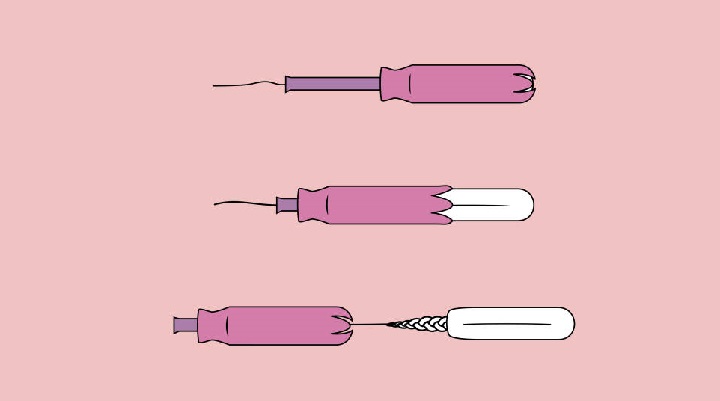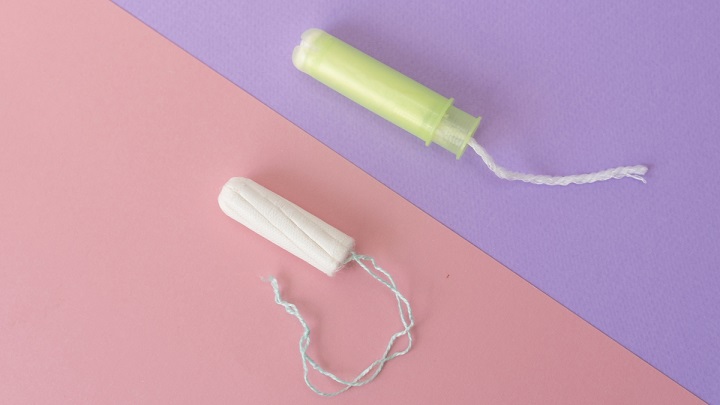A menstrual tampon is a sanitary product used to collect blood during menstruation. This health product has gained many fans today due to its small size and many benefits. Stay with us until the end of the article to learn the advantages and essential points of using this health product.
What is a tampon?
It is a cylindrical, soft product that absorbs menstrual blood inside the vagina. Tampons are one of the most comfortable menstrual products, usually made of pressed cotton, rayon, or a combination. Absorbent fibers used in production are bleached without using chlorine. Tampons are disposable and should be thrown away after each use.
Tampons usually consist of these parts:
- Applicator with the piston;
- blood absorbing part;
- A thread to remove.
The applicator is made of cardboard or plastic, and its use makes it easier to insert the tampon into the vagina. (Always remove the applicator after inserting the tampon.) Of course, not all tampons have an applicator.

active tampon
“Active” or “sports” tampons are suitable for people who exercise or are more active during their period. These tampons are more absorbent and provide more protection against leakage. Of course, you don’t have to use an active tampon during exercise or be an athlete to use an active tampon.
Scented tampon
According to many doctors, it is unnecessary to use scented tampons because the vagina can clean itself. The presence of external perfumes or cleansers may disturb the pH balance of the vagina and destroy the beneficial bacteria in the vagina. Therefore, many doctors recommend fragrance-free varieties.
Selection of size and absorption power
Not all people have the same period, and the bleeding rate of some is different from others. In addition, the amount of bleeding on additional days of the menstrual period is not the same; Some days are more intense, and some days are less. For this reason, some tampons are made to absorb more liquid and prevent leakage.
Tampons have different absorbencies, from low to extremely high. Always choose the lowest amount of absorption necessary for your menstrual flow. Tampons should be changed every 4 to 8 hours. Therefore, if you can use a tampon for 8 hours or more, its absorption power is very high.
If you have just started using tampons, it is better to use the small or regular size with the lowest absorption, usually thinner and easier to insert into the vagina for beginners.
If you removed the tampon after 4 to 8 hours and most of its parts were white, using a tampon with lower absorption power is better. Smaller tampons also lower the risk of toxic shock syndrome (TSS). But if the entire tampon is bloody or the blood has leaked into the underwear, you should use a tampon with higher absorption power. Most women need different sizes for different days of the menstrual period; For example, the average size at the beginning and end of the period and larger sizes with greater absorption power for the middle days when the intensity of bleeding is greater.
For added safety, change the tampon after 4 to 8 hours, even if there is no discharge.
How to use a tampon with an applicator
Before inserting the tampon, wash your hands to prevent harmful bacteria from entering the vagina. To insert a tampon with an applicator, proceed as follows:
- First, remove the tampon from the package. Make sure it is tight by gently pulling the tampon string.
- Before inserting the tampon, check if the tampon reaches the tip of the applicator by gently pressing the inner tube of the applicator (so that the tampon is slightly removed from the applicator).
- Place the tampon in the vagina while sitting or standing. You can use the toilet for sitting. If you prefer a standing position, place one leg on something so that it is higher than the other leg.
- Hold the tampon in the center and end of the outer part of the applicator. Place the tip of the applicator at an angle to your waist in the opening of the vagina.
- While holding the outer tube of the applicator, push the inner tube into the vagina until the tampon is entirely in place and the ends of the inner and outer lines of the applicator meet. To insert the tampon correctly, ensure that the two ends of the applicator tubes meet right in the opening of the vagina.
- Gently remove the applicator from the vagina. Make sure that the tampon thread hangs outside the vagina.
- Wash your hands after inserting or removing a tampon.
How to use a tampon without an applicator or finger
- Wash your hands and remove the tampon from the packaging.
- Place your index finger at the bottom of the tampon and hold its sides with your thumb and middle finger.
- Stand or sit on the toilet with one leg elevated.
- With your free hand, gently open the skin around the vaginal opening.
- Insert the tampon into the vagina and push it into the vagina with the index finger.
- If the tampon is in the right place, you should not feel it. If you feel the tampon, it means you need to push it a little further. The tampon thread should hang outside the vaginal opening.
- Wash your hands after inserting or removing a tampon.

The best time to practice inserting a tampon is when the bleeding is more intense because the tampon slides easily and without discomfort in the vagina. Do not practice tampon insertion when not on your period, as removing a dry tampon can be very painful.
If you cannot use a tampon due to pain and discomfort, or if it is still difficult for you to do so after several practices, see your doctor. You may have a minor structural abnormality in the vagina called a vaginal septum or a vaginal pain syndrome called vulvodynia, which can affect your ability to use a tampon or have sex.
How to remove a tampon
Relax the pelvic floor muscles when removing the tampon. Sitting on the toilet or standing and placing one foot on the bathtub’s edge are tricks that make tampon removal easier. All tampons have a thread at the end that you can pull to remove the tampon. Some worry that the tampon will remain in the vagina or slip into the uterus. However, this does not happen because the opening between the uterus and the vagina is not large enough for the tampon to pass through and enter the uterus.
A tampon should never stay in the vagina for more than 8 hours, even sleeping. If you slept more than 8 hours or forgot to remove the tampon, you should remove it immediately.
Tampon is stuck inside the vagina.
The tampon can remain inside the vagina for various reasons, for example:
- At the end of the menstrual period, you put a tampon in the vagina and forget to take it out.
- In the middle of your period, you forget you used a tampon and put another in your vagina. As a result, the first tampon was pushed into the vagina and returned further.
- Having sex while using a tampon causes the tampon to sink further into the vagina and not come out.
- The tampon thread has broken or entered the vagina.
For whatever reason, the tampon is stuck in the vagina; you should know that it remains inside the vagina and cannot go to another part of the body because the only other way for the tampon to pass is through the cervix at the top of the vagina, which is too small for the tampon to pass through.
Tampon stuck symptoms
- Awful smell: dried blood and bacteria collect around the tampon and cause a foul odor.
- Foul-smelling or foul-smelling discharge: If the shot is watery and brown and has a bad smell, there is a possibility that the tampon is left in the vagina.
- Pain or itching: sometimes, you don’t feel anything even though the tampon remains in the vagina, and sometimes you think a minor vaginal itching or even pain.
- Fever: High body temperature and high symptoms can indicate a tampon being stuck and cause an infection, such as toxic shock syndrome. Symptoms of toxic shock syndrome include:
- Sudden high fever;
- low blood pressure ;
- vomiting or diarrhea ;
- A sunburn-like rash, especially on the palms of the hands and feet;
- confusion;
- muscle pains;
- Redness of eyes, mouth, and throat;
- convulsions ;
- headache
How to remove a stuck tampon
Go to the bathroom and wash your hands well. Sit on the toilet and raise your legs on something like a stool. Push down a little as you would during a bowel movement. Then insert 1 or 2 fingers into your vagina and see if you can feel the tampon or thread. Use oil and lubricant if inserting your fingers into the vagina feels uncomfortable. When you feel the tampon, wrap your fingers around it and pull it out.
In 9 out of 10 cases, the problem is solved with this method. However, if you do not feel anything when you insert your fingers into the vagina or are unsure if there is a tampon, see a doctor. In the office, the doctor sees the inside of the vagina using a speculum and efficiently removes the tampon.
Common questions
1. Why should the tampon not stay in the vagina for over 8 hours?
Because tampons staying too long in the vagina creates a suitable environment for the growth of bacteria that can cause infection. In addition, it increases the risk of developing toxic shock syndrome, a rare infection complication.
2. Can you urinate with a tampon?
Yes. The tampon enters the vagina and does not block the urethra.
3. Can we swim while using a tampon?
Yes. For swimming, you can use a swimming pool tampon that has high absorption power. Of course, you should change the tampon after swimming, even if it is left in the vagina for a short time. Tampons usually absorb some water, which reduces the absorption of menstrual blood and can even cause bacteria to enter the vagina.
4. Why is tampon removal painful?
Tampon removal should not be painful. Relaxing the pelvic muscles can be effective. Removing a tampon that has not absorbed much blood is more painful. If your bleeding is light, use a tampon with less absorbency.
5. Is the use of tampons recommended for singles?
To use a tampon, you have to insert it through the vaginal opening, and this may change the hymen (hymen). So keep this point in mind to using this product.
you say
What is your experience in using tampons? Do you prefer tampons? Maybe a menstrual cup? Sharing your experience can be beneficial for others.
Warning! This article is only for educational purposes; to use it, it is necessary to consult a doctor or specialist.



